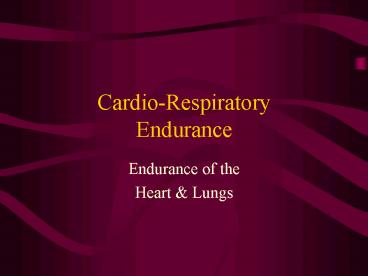Cardio-Respiratory Endurance - PowerPoint PPT Presentation
1 / 29
Title: Cardio-Respiratory Endurance
1
Cardio-RespiratoryEndurance
- Endurance of the
- Heart Lungs
2
Objectives
- How can you measure your pulse rate?
- What benefits are gained from participation in
activities promoting cardiovascular fitness? - Which health risk factors can be controlled with
cardiovascular training?
3
Objectives
- How can the training principles be applied to
improve cardiovascular fitness? - How do you determine the rate at which your heart
should be exercised?
4
Components of Physical Fitness
5
Components of Physical Fitness
- Body Composition
6
Components of Physical Fitness
- Cardio-Respiratory Endurance
7
Components of Physical Fitness
- Muscle Strength
8
Components of Physical Fitness
- Muscle Endurance
9
Components of Physical Fitness
- Flexibility
10
Components of Physical Fitness
- Body Composition
- Cardio-Respiratory Endurance
- Muscle Strength
- Muscle Endurance
- Flexibility
11
Cardio-respiratory Endurance
- Measures how long your heart and lungs can
continue to work efficiently - What do they do when they work?
- Muscles need oxygen
- Heart lungs work harder to supply extra oxygen
- Breathing becomes deeper faster
12
Circulatory and Respiratory Systems
- Work together
- Blood picks up oxygen from the lungs and carries
it to the heart - Heart pumps the oxygen to the working muscles
13
If youre in shape
- Heart is strong enough to pump blood thru the
system - Oxygen gets to working muscles and you keep going
and going
14
If youre not in shape
- You run out of oxygen
- And you have to
- STOP REST
15
Why Is Cardiovascular Fitness Important?
- Increases energy level
- Look good
- Ability to provide oxygen continuously to working
muscles over an extended time
16
Measuring Heart Rate
- Pulse
- pressure of blood on artery walls
- Use fingers rather than thumb
- Count 10 sec. and multiply by 6
17
Maximal Heart Rate
The heart rate that should not be exceeded during
exercise found by subtracting one's age from 220
18
Target Heart Rate Formula
- Safe Lower Limit
- (220-age) x 60 Lower Limit
- (220-14) x 60 Lower Limit
- (206) x 60 Lower Limit
- 123.6
3 of 4
19
Target Heart Rate Formula
- Safe Upper Limit
- (220-age) x 90 Upper Limit
- (220-14) x 90 Upper Limit
- (206) x 90 Upper Limit
- 185.4
Objective
4 of 4
20
Heart Rate
- Carotid Artery
- Maximum Attainable Heart Rate
- Resting Heart Rate
- Target (Training) Heart Rate
21
Levels of Fitness
If you are going to work-out determine your
fitness level and work at the following of
maximum heart rate
- High Fitness 90
- Average Fitness 75
- Low Fitness 60
- Sedentary 50
22
Applying Training Principles
- Principle of Overload
- Frequency minimum 3 times per week
- Intensity target heart rate
- Time minimum 20 min. at target heart rate
Objective
1 of 3
23
Progression
- The best benefits are gained from starting slowly
gradually increasing the amount over a period
of time
24
Principle of Progression
- Increase overload gradually by
- increasing pace
- increasing distance
2 of 3
25
What type of Activities improve
cardio-respiratory endurance?
- Aerobic Activities
- Ones in which large amounts of oxygen are
required continually for a long period of time. - Vigorous, continuous rhythmic!
26
Principle of Specificity
Choose an aerobic activity to improve
Cardio-Respiratory Endurance
- Swimming
- Jump roping
- Rowing
- Bench stepping, stairs
- Field sports soccer, speedball, field hockey,
lacrosse, rugby
- Aerobic dance
- Tennis, badminton, racquetball
- Biking
- Jogging, running, walking
- In-line skating
- X-C skiing
27
Risk Factors
- I can control
- Inactivity
- Obesity
- High blood pressure
- High cholesterol
- Stress/tension
- Smoking
- I cant control
- Gender
- Heredity
- Age
Objective
28
Cardiovascular Benefits of Exercise
- Reduces the risk of dying prematurely
- Strengthens heart, makes more efficient
- Decreases atherosclerosis
- Clears fats from bloodstream
2 of 3
29
Cardiovascular Benefits of Exercise
- Helps control weight
- Improves concentration
- Promotes positive self-concept
- Reduces feelings of depression and anxiety
3 of 3































